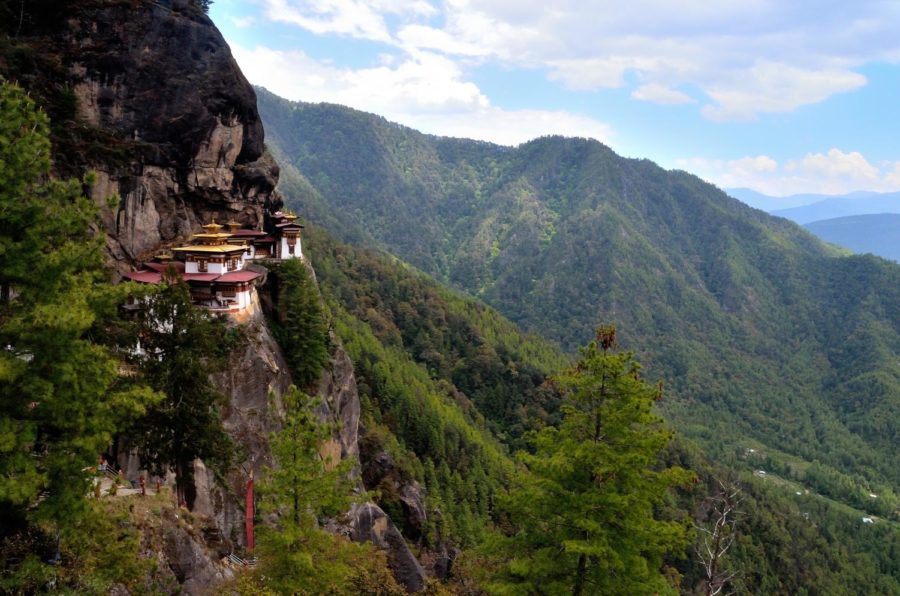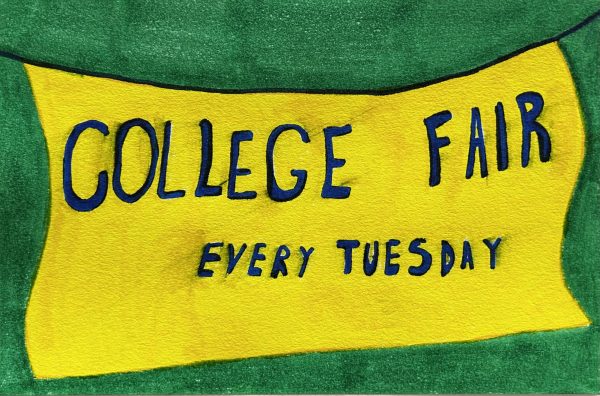Bhutan: the most interesting country you’ve never heard of
By INDIA Trotter – Own work, CC BY-SA 4.0, https://commons.wikimedia.org/w/index.php?curid=68198427
Tiger’s Nest, a monastery high in the mountains of Bhutan, is pictured.
In 2023, much of the world is on a similar trajectory: economies opening, wide-scale capitalism, and movement towards a more globalized world system. Particularly from our perspective as Americans, it seems like the rest of the world is becoming more and more unified and, to put it bluntly, ‘like us’. However, there is one small country in the Himalayas that is doing things its own way, and is arguably one of the best in the world: the Kingdom of Bhutan.
Sandwiched between China and India, the Land of the Thunder Dragon (Bhutan’s famous nickname) is a Buddhist monarchy of about 777,000 people located high in the mountains. Despite being such a tiny country, Bhutan has some truly excellent policies and features that make it stand out among its more famous neighbors.
Most likely, you know very little about Bhutan. And that is entirely intentional. In order to reduce the number of visitors and keep the nation clean, the Bhutanese government works very hard to keep their country as hidden as possible. This policy goes as far as to make tourists pay 200 dollars a day simply to be in the country, as well as requiring all tourists to have a guide with them while traveling around.
These policies are clearly working, as Bhutan is one of the only carbon-negative countries in the world. They also ensure their carbon negativity by constitutionally guaranteeing that at least 60% of the country must be covered in forest, providing free electricity to farmers to reduce the burning of wood for fuel, and generating 99.9% of their electricity from hydroelectric power (producing so much of it, in fact, that they export the extra to India). The country is also covered in national parks and reserves, often preserving entire mountains, valleys, or rivers. Mountaineering has been completely banned since 2003, which leaves Gangkhar Puensum, Bhutan’s highest point, as the highest unclimbed mountain in the world.
But Bhutan’s ‘purity’ goes much further than just its environment: the government also manages to make great social strides by prioritizing the development of the mind and heart above the economy. This follows their policy of Gross National Happiness, a philosophy that has guided the government since its implementation in 2008. It follows the four pillars of preservation of culture, sustainable and equitable development, equality before the law, and ecological sustainability. This policy has been used instead of Gross Domestic Product (GDP), which the government has not tracked since the implementation of the GNH, due to their belief that emotional and spiritual health should be valued above economic growth.
Keeping the environment safe and clean is only one of the ideals that the country follows to keep its GNH score high. They are also very strict against aspects of modernity—television and the internet were completely banned until the last king legalized it upon his Silver Jubilee in 1999, making Bhutan the last country in the world to introduce television. The country does not have a single traffic light (reportedly, a single light was installed in the capital a few years ago, only to be quickly removed following public outcry and was replaced with a now famous white-gloved traffic officer, who directs traffic from a special gazebo-like building), and they are also the only nation in the world where the sale of tobacco, and smoking in general, is entirely banned. There wasn’t even a single road in the country until 1961.
Cars have become more common in recent decades, particularly in the capital of Thimphu, where around half of all the cars in the country reside, but transportation in the country is still relatively limited. The country has 4 airports, and only one of which (Paro) is an international airport, and which only operates flights to other parts of South Asia, Bangkok, and Singapore. The airport itself is an hour’s drive away from Thimphu, due to the valley Thimphu is located in having mountains too high to build an airport safely. Of course, this doesn’t mean that Paro International is in a flat location. With surrounding peaks as high as 18,000 feet, Paro is considered one of the world’s most challenging airports, so much so that only 8 pilots are certified to land there. Landing at the airport is also only allowed during days of clear sky and sun, and only from sunrise to sunset. The airport itself didn’t even have a terminal building until 1999. The other 3 airports (Bathpalathang, Gelephu, and Yongphulla) are all of recent construction (2011, 2008, and 2010, respectively), and are all domestic single-lane airstrips.
The political system of Bhutan is relatively new, as the country only became a constitutional monarchy in 2008, and political parties have thus only had about 2 decades to develop. The current Prime Minister is former surgeon Lotay Tshering of the DMT party. The government itself has gained a lot more power in the last decade because of the monarchy’s move away from full national governance.
The monarchy itself is fascinating in itself. Established in 1907, the Wangchuck dynasty has dominated the country, with the leader of the family holding the position of Druk Gyalpo (literally translated as ‘Dragon King’). They took over the country by overpowering the local monarchs that governed the land before the unification, and gaining the favor of the British Empire and then India to remain independent during colonial times. The monarchy has a fairly high approval rating, especially since the establishment of a constitutional monarchy, which was originally planned under the popular former king Jigme Singye Wangchuck and then fully implemented by his son, and the current king, Jigme Khesar Namgyel Wangchuck. Since the transition to a democracy, the monarchy no longer has most of its political power, but the population of the country still holds the royal family in high regard.
And that provides a great transition into the culture of Bhutan. The country generally follows the culture of neighboring Tibet and other Himalayan regions, that being one of the serious Buddhist traditions—prayer flags flutter on hillsides, offering up prayers to benefit all nearby sentient beings. Houses each fly a small white flag on the roof indicating the owner has made the offering payments to appease the local god. About 75% of the population is Buddhist, though 23% of the population is Hindu, mostly in the lower valleys near the southern border with India.
Each valley is dominated by a huge dzong, or high-walled fortress which serves as the religious and administrative center of the district. Dzongs are a tradition that originated in Tibet, and historically were used to defend the valleys from outside invaders, and are now the main centers of Bhutanese culture. Buddhist children typically join the monasteries between the ages of six to nine years of age where they are assigned a headmaster to watch over them. There, they learn Buddhist traditions, how to read Chhokey (the language used in ancient Bhutanese texts), as well as Dzongkha and English. Eventually, they will choose between either studying theology and Buddhist theory, or taking the more common path of becoming proficient in the rituals and personal practices of the faith.
As well, when considering the culture of the nation, the Driglam Namzha is essential to talk about. While it is far too complicated to talk about in short form here, it is essentially the official behavior and dress code of the country, set into law in 1990. This code is also rather a controversial can of worms because of its imposition on the minorities in the country, particularly the Nepalese-origin Lhotsampa people, but that is far too much to discuss here.
Bhutanese society differs from most of its neighbors because of the general societal views towards women’s rights and roles in society—dowry customs do not exist, and the inheritance of most things is matrilineal. In the workforce, Bhutan has had a long history of women and men working in equality in agriculture, commercial industry, and other sectors.
Bhutanese citizens are also incredibly proud of their national sport, archery. Archery originally evolved as a way to defend invaders from behind the walls of the dzongs, but as the world around them became more peaceful, archery took on a more recreational form. Today it is common in cities, towns, and villages across the country. Soccer is also wildly popular—though the national soccer team is ranked 185th out of 211 in the FIFA ranking (they have only won six competitive fixtures and have a goal difference of −279), they are a beloved team and often find much support at their home of Changlimithang Stadium. The stadium itself is actually more well known than the team itself, as at its height of 7,500 feet above sea level, it is highly controversial in the soccer world because of the extreme difficulty of breathing. This gives the home team a massive advantage due to their acclamation to the conditions, while the opposing teams are often left gasping for air.
And some other short facts—the national architecture style is just that: national. It is signed into law that all buildings must follow the code of style, including sloped roofs, wood frontages, and no nails or iron bars. Plastic bags are entirely banned, even for tourists. Education and healthcare are free, subsidized in part from the 200-dollar-a-day price tag the government places on tourists. Having multiple spouses is rather common, and not just among men: it is also common for women to have many husbands.
If all of this has caught your eye, and perhaps you are willing to stomach the expensive daily price tag, then Bhutan has a lot to offer you. The country’s most famous landmark is the spectacular Tiger’s Nest, a monastery balancing thousands of feet above the ground on the side of a mountain. You can get there via a hiking trail that takes a few hours to make it to the top. Hiking is permitted on a dozen or more registered trails, so make sure to check before heading out. As well, remember to dress modestly (especially in dzongs), remove shoes before entering most buildings, and get permission to do so while you are at it. If you are planning to visit, make sure to be as respectful and caring as possible, so that Bhutan can carry on its cultural protection and preservation into the future.

Finn is a senior at GHS and a second year staff writer for The Gillnetter. He enjoys reading, writing, reading about writing, and biking around Gloucester...










![The Volleyball team poses after their win. [Photo courtesy of GHS Volleyball]](https://thegillnetter.com/wp-content/uploads/2025/10/IMG_6936.jpg)


![The GHS/MERHS senior cross country runners pose together on Senior Night. [Photo courtesy of Manchester-Essex Athletics]](https://thegillnetter.com/wp-content/uploads/2025/10/Screenshot-2025-10-10-at-11.18.29-AM.png)






















![The Volleyball team poses after their win. [Photo courtesy of GHS Volleyball]](https://thegillnetter.com/wp-content/uploads/2025/10/IMG_6936-600x476.jpg)


